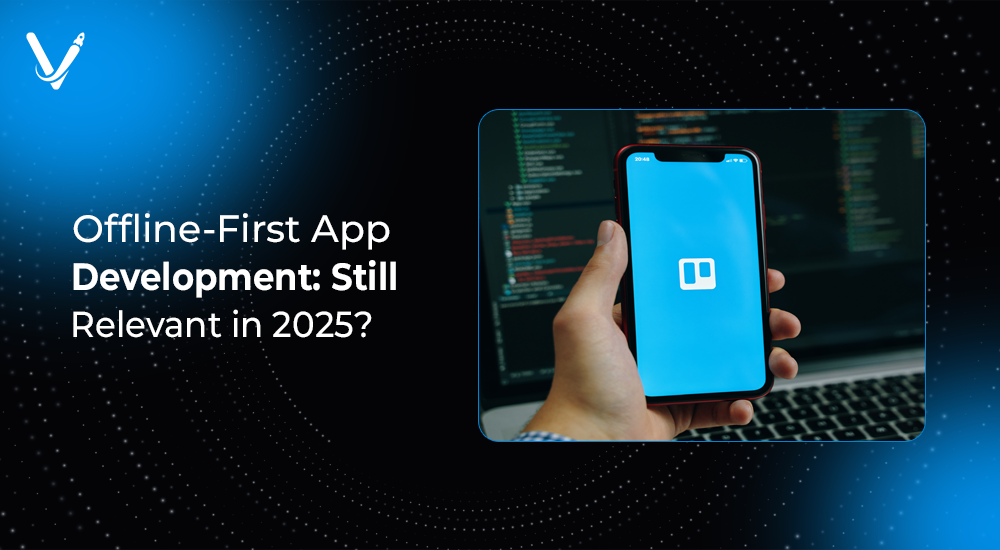Offline-First App Development: Still Relevant in 2025?


- Jul 20, 2025



The tech landscape in 2025 is dominated by lightning-fast 5G networks, AI-integrated cloud services, and ultra-connected smart devices. Despite this, offline-first app development remains not just relevant but often critical. Users expect seamless digital experiences even when signals fade or connectivity drops. Developers face increasing pressure to build applications that are resilient, responsive, and secure—online or offline.
This blog explores the enduring value of offline applications, practical use cases, development strategies, and the pros and cons of building with an offline-first mindset. We’ll also dive into how emerging technologies are transforming this space and why mobile-focused businesses, especially those offering mobile app development services, should continue to prioritize offline readiness in their 2025 strategies.
Offline-first is an architectural approach in which apps are designed to work without an internet connection. The core functionality of the application remains usable, and once connectivity is restored, data syncs automatically. This approach focuses on:
An offline app isn't just a fallback option—it’s a primary consideration in its design.
When asking, “What was the first app that introduced offline capabilities?”, we often look to note-taking tools and email clients. Early apps like Microsoft Outlook and Palm OS memos allowed users to draft, view, and organize data without a network connection. These laid the foundation for today's sophisticated offline applications.
Despite massive improvements in mobile networks, offline capabilities remain essential due to:
Mobile app development services often target sectors like:
Users can trust that the app will function no matter the network situation. No more “Error fetching package list offline” scenarios when connectivity issues strike during installations or updates.
Users interact with content instantly—no loading spinners or dependency on remote servers. It also ensures a frictionless onboarding experience, especially in first app usage scenarios.
Offline apps reduce data consumption and server calls, saving users money and improving battery life—crucial for Android application and iOS application performance.
Online to offline app security protocols allow developers to manage and encrypt data locally. Offline apps can:
If you're weighing the offline development tools advantages and disadvantages, always assess your use case, expected environment, and user behavior.
Google Docs exemplifies robust offline application behavior. Users can edit documents without internet access, and the platform automatically syncs when reconnected.
While primarily streaming services, both platforms allow users to download content for offline use, addressing unreliable data coverage.
In 2025, no data games remain top downloads in app stores. Titles like Subway Surfers, Alto’s Odyssey, and Shadow Fight continue to dominate in regions with limited connectivity. Offline gameplay is a retention booster.
Writers and professionals prefer tools that allow them to jot ideas or notes without relying on connectivity. These offline writing apps offline help prevent data loss and increase portability.
When architecting an offline-first app, database choice is crucial.
Each offline-first database has trade-offs in complexity, performance, and platform compatibility.
Avoid massive syncs. Use timestamp-based or user-action-based syncs to minimize data usage.
Many bugs surface only when connectivity is lost. Simulate low-bandwidth or offline environments during development.
With libraries like Redux Persist, AsyncStorage, and WatermelonDB, developers can create responsive Android apps and iOS apps that work offline.
Flutter’s local storage and SQLite support, combined with its UI performance, make it ideal for offline apps across platforms.
For progressive web apps and hybrid solutions, Ionic offers service workers and local data strategies to support offline capabilities.
App store optimization (ASO) increasingly favors applications that offer offline modes.
Offline-first apps are crucial for teams in oil fields, remote logistics, and site inspections. These apps reduce error rates and ensure compliance reporting even without Wi-Fi.
Retailers use offline-capable Android applications to process payments, scan products, and handle transactions—even if the central server is unreachable.
Sensitive data is often handled offline for security. Syncing happens only under secure, verified networks.
Even error fetching package list offline bugs can expose vulnerabilities if not properly handled.
Offline-first is not a fading trend—it’s evolving.
Any reliable android app development company or iOS app development company USA now factors offline-readiness as a standard offering.
The digital world is more connected than ever, but it is not always connected. Users expect responsiveness, privacy, and usability—even in low-signal environments. Offline-first development empowers businesses to meet these expectations.
If you’re launching an app that demands resilience, user trust, or global reach, integrating offline application strategies is not just smart—it’s necessary.
Vasundhara Infotech, a leading provider of mobile app development services, specializes in building robust, future-proof applications with full offline capabilities. Whether you're planning your first app or scaling an enterprise suite, we bring the expertise and tools to help you deliver exceptional, offline-ready experiences.
Copyright © 2025 Vasundhara Infotech. All Rights Reserved.